- NEWS: Rising health care costs eat up new state revenues
- BRIEFS: On the death penalty, abortion, time, plastic bags, more
- CALENDAR: Child advocate bill expected on Senate floor
- TALLY SHEET: Key committee introduces its proposal for state budget
- TOP FIVE: Census, school safety, opioids, woman friendly and courts
- COMMENTARY, Brack: Hardship made the South what it is today
- SPOTLIGHT: United Way Association of South Carolina
- MY TURN, Taylor: 6th-lowest residential property taxes? Not so fast, South Carolina
- FEEDBACK: Send us your thoughts
- MYSTERY PHOTO: A pretty interesting ruin
- S.C. ENCYCLOPEDIA: Converse College
NEWS: Rising health care costs eat up new state revenues
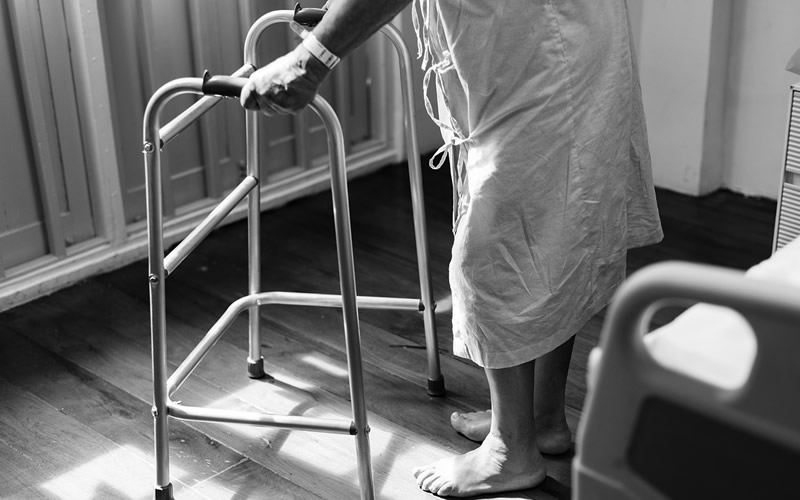
By Lindsay Street, Statehouse correspondent | Like any household budget, rising health care costs are dominating the state’s 2018-19 budget which House members begin debating Monday. Employee health care and government-subsidized health care took more than half of the meager new revenue projected for state coffers for the new budget.
The state is projected to see $492 million in new revenue for the $8.2 billion general fund budget. Of that amount, $326 million is recurring money, meaning it is expected year after year and can provide stable funding for items such as employee benefit increases and pay increases. And that’s where the House’s budget-writing panel has largely directed the pool of new money.
The proposed budget by the House Ways and Means Committee calls for no cuts to state programs or agencies and no tax increases. Click here to see the House budget proposal.
While debate on the House-crafted budget begins next week, but there won’t be much to debate, according to House Republicans and Democrats.
“There is a not a windfall of dollars into the budget but there are certainly many needs within state government,” said Rep. Gary Simrill, who serves as first vice chair to the House Ways and Means Committee. The York Republican said the budget is “well prioritized” and “well thought-out,” adding, “I don’t see any changes that need to be made in the budget.”
After the House passes the budget, it will go to the Senate, where any changes will move it into a House-Senate conference committee before it heads to the governor’s desk. State senators have already begun the committee process for evaluating budget requests.
“It seems to be shaping up for a ho-hum budget year,” said S.C. Sen. Vincent Sheheen, D-Kershaw. He serves on the Senate’s Finance Committee. “We’re barely able to meet our obligations each year. You can’t do anything new or innovative or exciting when you’ve basically have an unstable tax and budget system and you’re struggling every year to keep up with inflation.”
Where the money is going
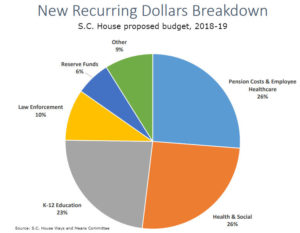 In the proposed House budget for $326 million new recurring revenue, 26 percent will go toward increasing health care costs for state employees, 26 percent will go toward health and social programs, 23 percent will go toward K-12 education, 10 percent will go toward law enforcement and 6 percent will go toward reserve funds. The remaining 9 percent is divvied up among various agencies.
In the proposed House budget for $326 million new recurring revenue, 26 percent will go toward increasing health care costs for state employees, 26 percent will go toward health and social programs, 23 percent will go toward K-12 education, 10 percent will go toward law enforcement and 6 percent will go toward reserve funds. The remaining 9 percent is divvied up among various agencies.
Here’s a breakdown for some of the proposed new spending from recurring revenues:
- $32 million for year two of the state’s pension fund fix.
- $56.4 million to cover health care increases for state employees.
- $26.4 million toward Medicaid to continue same level of service.
- More than $11 million in increased state funding specifically aimed at addressing the opioid epidemic through state agencies.
- $60 million for 2 percent salary increase for teachers.
- $5 million to increase the statewide minimum starting salary for a beginning teacher from $30,000 to $32,000.
- $32 million to maintain the base student cost at $2,425.
- $3 million for school buses.
The lion’s share of the $166 million in non-recurring revenue — 30 percent — will go toward higher education, including $50 million for capital projects and maintenance needs around the state. That revenue stream also includes 15 percent for Department of Social Services Child Support Enforcement System, 3 percent for state school buses — or about $5 million — 7 percent for statewide beach renourishment and more.
Down the road
The House Ways and Means Committee took months crafting the budget, which is expected to be passed before March 15, less than two weeks after all House members receiving the thousand-page tome.
S.C. Rep. Todd Rutherford, the House minority leader from Richland County, who also serves on Ways and Means, said any changes to the budget now is “shuffling chairs on the Titanic.”
“It’d be hard for someone else to step in to say, ‘I want this money here or there,’” Rutherford said. That money would have to come from somewhere else. “We’re talking about things that are absolute necessities.”
On the other side of the aisle but in the same committee, Simrill agreed, but with a more positive view.
“As this budget was crafted, one reason it went through Ways and Means fairly quickly is because it sought to do the most in the areas we felt were important,” Simrill said. “It couldn’t be a shotgun, it had to be a rifle in the way this was crafted.”
The seemingly lackluster budget leaves potential governance questions to be taken up in the coming years. Republicans, like Simrill, are pushing tax reform and a looming federal tax conformity question as an answer toward helping the state meet its obligations. Democrats, like Sheheen and Rutherford, want to see other revenue options explored.
“The Republican leadership simply wants to charge people more on their taxes and it’s a recipe for disaster,” Rutherford said. “I don’t want to raise taxes; I want to go and get revenue from other sources. At some point this state has got to wake up and realize if we don’t bring in new revenue we are simply going backwards.”
Rutherford pointed to legalizing luxury gaming and marijuana — moves taken in other states — that could bring in a hefty revenue stream to the state. In Nevada, where recreational marijuana was legalized, the state saw $30 million windfall in six months. In South Carolina, the question of medical marijuana remains stymied in committee.
Simrill was dubious such new revenue streams would be all profit.
“More money is not the only answer. Depending on how you derive revenue there’s a cost to deriving revenue,” Simrill said. He added the best solution is to “right-size and spread the tax base better through tax reform and conformity.”
One seemingly bipartisan question remains: taking on debt to meet obligations. In past interviews with Statehouse Report, Ways and Means Chair Brian White, R-Anderson, has expressed support for increasing the state’s dwindling debt load to pay for items such as building repairs. But bonding is expected to wait at least until next session,, lawmakers said
- Have a comment? Send to: feedback@statehousereport.com.
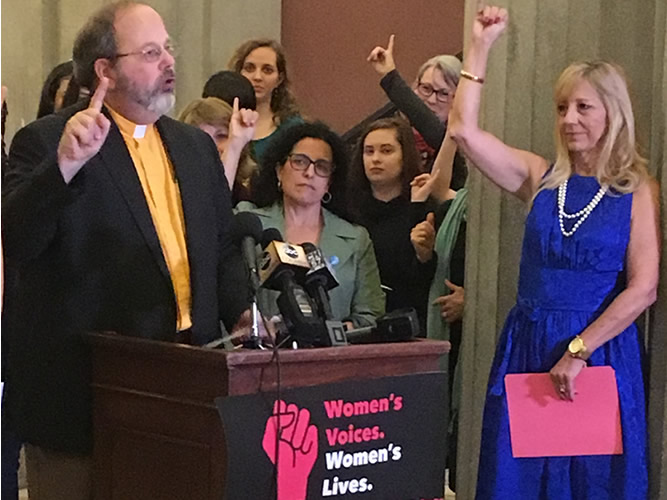
NEWS BRIEFS: On the death penalty, abortion, time, plastic bags, more
![]() Staff reports | State lawmakers earned national headlines this week after the Senate approved a bill that would make death by electrocution mandatory for death row inmates in the state.
Staff reports | State lawmakers earned national headlines this week after the Senate approved a bill that would make death by electrocution mandatory for death row inmates in the state.
The bill is in response to the state having difficulty obtaining lethal injection drugs. Currently, death row inmates can choose between the electric chair and lethal injection. The bill makes the electric chair the only option should the drugs not be available. The House is expected to support the move.
Here are other items that happened this week:
Abortion ban draws heat. Two proposed bills banning on abortions, both of which advanced to the Senate floor, drew protesters to Columbia this week. The “personhood” bill has upset doctors and others in South Carolina because it would give legal rights to fertilized eggs and could have big consequences for fertility treatments and some birth control medications.
House accuses Senate of foot-dragging. Or as one journalist observed: “Signs of March: … SC House bagging on how slow Senate is.” This week, House Speaker Jay Lucas held a press conference to complain about the slow-moving Senate. Unruffled by the allegations, some senators have told Statehouse Report that they spend more time with issues, especially the nuclear issue, and don’t shoot from the hip.
Long-time House member to retire. S.C. Rep. Greg Delleney, a Chester Republican who chairs the House Judiciary Committee, announced he would l not seek reelection in 2018. He has served for 27 years. Read more.
Safe sleeping bill sent to House. A bipartisan Senate bill that says parents of newborns should be informed of safe-sleeping practices and the causes of Sudden Infant Death Syndrome has earned a favorable vote from the Senate and has been sent to the House.
‘Sanctuary cities’ targeted. Gov. Henry McMaster’s push for eliminating cities in the state that harbor illegal immigrants has passed a House committee. Critics say the move is just pandering for votes.
Utility bills cut in House. The House has voted 107-1 to cut utility bills following the cessation of the Summer nuclear project. Read more.
End of Daylight Saving floated. A bill from S.C. Sen. Harvey Peeler, R-Cherokee, seeks a study of the state ending Daylight Saving Time and possible consequences. It’s, err, timely, considering the time change is this weekend. Read more.
The ban on plastic bag bans. The House is still mulling over whether it should prohibit local governments from banning or taxing “auxiliary containers.” The proposal drew heated discussion and a large crowd this week. Read more.
House panel seeks to increase dropout age. A House bill is seeking to raise the age a student can drop out of school in South Carolina. The current age is 17, and the bill seeks to raise the age to 18.
House committee moves to eliminate solar subsidies. The bill could make it more expensive to install solar panels on home rooftops.
- Have a comment? Send to: feedback@statehousereport.com.
CALENDAR: Child advocate bill expected on Senate floor
![]()
Staff reports | The Senate may finally vote on a proposal that would establish an umbrella watchdog over the state’s various child-centric agencies.
The bill S.805, which would create a “children’s advocate,” has been on the Senate floor for a month. S.C. Sen. Vincent Sheheen, D-Kershaw, who cosponsored the legislation, said he expects the Senate to move on it in the coming week.
Here are other items coming up in Columbia next week:
- House budget debate. Debate in the House over how the state should spend $8.2 billion in state revenues in 2018-2019 will begin 1 p.m. Monday.
- Utilities in subcommittee in Senate. A Senate Judiciary subcommittee will review four pieces of legislation tied to the $9 billion canceled nuclear expansion project after the Senate adjourns Tuesday. The meeting will be in room 308 in the Gressette Building. The bills include: comprehensive utility reform; electric rates and the Base Load Review Act; a consumer advocate for utilities; and a measure on preservation of the V.C. Summer construction area. Click here for the agenda.
TALLY SHEET: Key committee introduces its proposal for state budget
![]() Staff reports | The House Ways and Means Committee formally introduced its state budget for 2018-19 this week to give it the required number of days it needs to be on legislators’ desks before debate starts next week. To read the bills, click the links below.
Staff reports | The House Ways and Means Committee formally introduced its state budget for 2018-19 this week to give it the required number of days it needs to be on legislators’ desks before debate starts next week. To read the bills, click the links below.
- H. 4950(Word version) — Ways and Means Committee: A BILL TO MAKE APPROPRIATIONS AND TO PROVIDE REVENUES TO MEET THE ORDINARY EXPENSES OF STATE GOVERNMENT FOR THE FISCAL YEAR BEGINNING JULY 1, 2018, TO REGULATE THE EXPENDITURE OF SUCH FUNDS, AND TO FURTHER PROVIDE FOR THE OPERATION OF STATE GOVERNMENT DURING THIS FISCAL YEAR AND FOR OTHER PURPOSES.
- H. 4951(Word version) — Ways and Means Committee: A JOINT RESOLUTION TO APPROPRIATE MONIES FROM THE CAPITAL RESERVE FUND FOR FISCAL YEAR 2017-2018, AND TO ALLOW UNEXPENDED FUNDS APPROPRIATED TO BE CARRIED FORWARD TO SUCCEEDING FISCAL YEARS AND EXPENDED FOR THE SAME PURPOSES.
ALSO INTRODUCED:
State senators introduced 27 bills during the week, while House members introduced another 54 bills as they prepared for budget week. Most introductions were honorary resolutions, but bills of substance included:
Free expression. S. 1085 (Grooms) seeks to enact the Camus Free Expression Act to provide that outdoor areas of campuses are traditional public forums, with several provisions including some restrictions.
Guns in schools. S. 1102 (Goldfinch) seeks to amend state law to allow military science instructors to carry firearms on school campuses, with training requirements and more provisions.
Senate attorneys. S. 1105 (Corbin) seeks to prohibit senators who are attorneys from appearing as an attorney in a magistrate court in counties that the senator represents.
Agriculture Commission. H. 5086 (Funderburk) seeks to restructure the state Agriculture Commission, including deleting its power to adopt policies, rules and regulations, and to approve budget requests.
School safety. H. 5091 (White) seeks to allow public and private schools to install and use “lockdown magnetic door strips” on classroom door frames to improve security, with other provisions.
Judicial merit. H. 5105 (Magnuson) seeks to revamp the state Judicial Merit Selection Commission’s procedures related to membership, with several provisions.
State judges. H. 5106 (Magnuson) seeks a constitutional amendment to change how state judges are picked by having them appointed by a governor with advice and consent of the Senate, with other provisions.
- Find all bills.
- Have a comment? Send to: feedback@statehousereport.com.
TOP FIVE: Census, school safety, opioids, woman friendly and courts
![]() By Lindsay Street, Statehouse correspondent | Our weekly Top Five feature offers big stories or views from the past week or so with policy and legislative implications that you need to read because of how they could impact South Carolina. If you have stories to suggest to our readers, send to: feedback@statehousereport.com.
By Lindsay Street, Statehouse correspondent | Our weekly Top Five feature offers big stories or views from the past week or so with policy and legislative implications that you need to read because of how they could impact South Carolina. If you have stories to suggest to our readers, send to: feedback@statehousereport.com.
- Census overlooks rural, southern counties, McClatchy DC, Feb. 26, 2018.
The South — and its rural areas in particular — is a difficult region for federal officials to count population accurately every 10 years, according to this story. The Census Bureau originally had plans to get more workers on the ground in rural areas, but those plans have been scrapped under the Trump administration. Compounding the concerns, workers will not do follow-ups at vacant homes, only leaving a paper questionnaire at the door, which can be mailed in or submitted online. But mailing in requires a stamp and following-up online requires Internet access — two things that could lower return rates, according to this article. An excerpt:
“Rural counties make up nearly 80 percent of the nation’s 316 ‘hard-to-count’ counties with low Census mail return rates, said William O’Hare, a Virginia demographer and Census consultant who studies rural populations. Of the 93 hard-to-count counties with majority-minority populations, 75 are in rural areas, he said.”
- State report on school safety misses key incidents, Greenville News, March 1, 2018.
The South Carolina Department of Education’s official school safety report, Persistently Dangerous Schools Report, offers incomplete and misleading information, according to this article. The report is designed to provide information on crime and violence in South Carolina schools. An excerpt:
“It includes no mention of the 2016 Townville Elementary School shooting in which 6-year-old student Jacob Hall was fatally wounded and three others were injured, and it includes no record of weapons offenses in the Greenville County school district from 2015 to 2017, though records reveal several incidents involving guns took place on local campuses during that time. State education department and school district officials said technical issues and discrepancies in how districts report incidents caused the omissions.”
- States that expanded Medicaid see better results with opioid hospitalizations, Center for Budget and Public Policy, Feb. 28, 2018.
States like South Carolina that didn’t expand Medicaid are not seeing the dramatic drop in uninsured people being hospitalized for opioid-related reasons, according to this article. An excerpt:
“In Medicaid expansion states, the uninsured rate for opioid-related hospitalizations plummeted by 79 percent, from 13.4 percent in 2013 (the year before expansion implementation) to 2.9 percent in 2015. The decline in non-expansion states was a much more modest 5 percent, from 17.3 percent in 2013 to 16.4 percent in 2015. While both expansion and non-expansion states saw sizable declines in their overall uninsured rates during this period, Medicaid expansion appears to have been especially critical for expanding coverage to those with OUDs (opioid-use disorders).”
- Murder rate, health care lead to low-ranking for South Carolina on woman-friendly list, WalletHub, March 5, 2018.
South Carolina was ranked No. 46 of 50 for being woman-friendly across 23 key indicators. The state has been under fire for years for its homicide rate of women, which was one of the indicators considered for the ranking. Louisiana was ranked last, and Minnesota was ranked first. An excerpt:
“Women represent nearly two-thirds of all minimum-wage workers in the U.S. Their political representation also suffers, as women make up 51% of the U.S. population but only 22% of the Senate and 19.3% of the House of Representatives. And the prevalence of sexual harassment has become a prominent issue in 2018’s political landscape, from #MeToo to #TimesUp.”
- Court reporter shortage causes lost taxpayer money, The Post and Courier, March 4, 2018.
South Carolina courts are lacking trained stenographers to transcribe verbatim records of court proceedings. The shortage is causing last-minute cancellations of hearings, which wastes taxpayer money and adds stress on victims, witnesses and families, according to the report. An excerpt:
“More than a quarter of court reporter positions within the S.C. Judicial Department are vacant. With 36 job openings and only 94 reporters working in family and circuit courts across the state, officials said it can be difficult and sometimes impossible to find an employee to fill in when a reporter calls off work. Until recently, vacancies over the past five years hovered at 20 to 25 openings, said Tonnya Kohn, interim director of S.C. Court Administration, which supervises state-employed reporters.”
- Have a comment? Send to: feedback@statehousereport.com.
BRACK: Hardship made the South what it is today
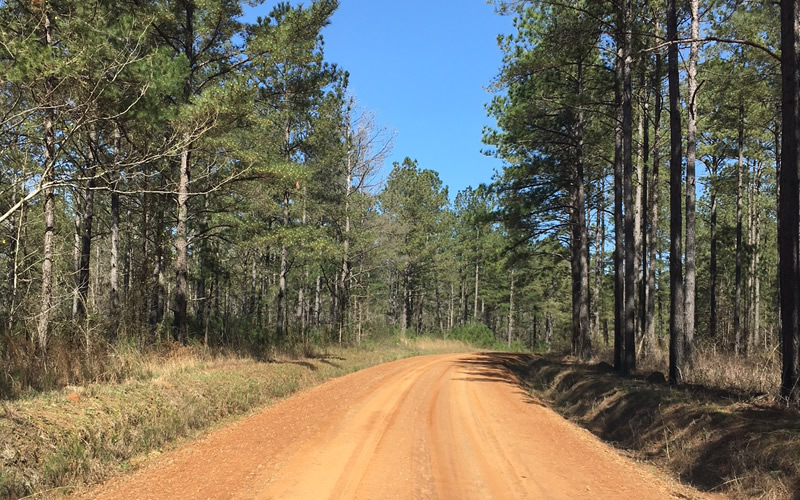
By Andy Brack, editor and publisher | People today often have a tough time imagining the scarcity and sameness of living 100 years ago in the rural South of my grandfather, a 9-year-old tenant farmer in middle Georgia.
 There were no smartphones or Amazon deliveries. People were lucky if they had iceboxes to preserve some fresh food. Cars were few and far between. Folks got to the nearest small town by a horse-drawn or mule-pulled wagon to pick up the few supplies, often on credit, that they couldn’t grow, patch, make or find. They’d buy fatback, tobacco, fertilizer, seeds and flour.
There were no smartphones or Amazon deliveries. People were lucky if they had iceboxes to preserve some fresh food. Cars were few and far between. Folks got to the nearest small town by a horse-drawn or mule-pulled wagon to pick up the few supplies, often on credit, that they couldn’t grow, patch, make or find. They’d buy fatback, tobacco, fertilizer, seeds and flour.
On the farm, they’d make butter from milk from their own cows. They’d get a little protein from eggs or a chicken whose time had come. Fresh vegetables and those canned for the lean months came from a large family garden. Children would sweep the yard, not mow, to control the chicken poop, which would be recycled into the soil. When something broke, they’d fix it. Little was thrown out.
“I wore feed sack dresses,” recalls my mother, born in Arkansas during the Depression. “They were cute because they had great patterns on them.”
There was little variety in a daily life where the toilet was a privy outside or a chamber pot, also known as a “slop jar,” in the corner of the room. From sunup to sundown, there was farm work. Breakfast was generally the same. The big meal was dinner at midday. At night, folks on farms across the Deep South would have the same old leftovers. Things were better in summers when vegetables filled bowls and gardens were rural saviors. But in lean times, particularly during winters, nutrition generally was limited to three colors: white, tan or brown.
Unlike clichés of the rural Southern past, most people didn’t grow up hungry. Still, there wasn’t much fat on them. They were tough, hardscrabble people.
THE ONE THING rural Southerners of days gone by had in abundance was hardship. It shaped their characters and the region’s future. From hardship emanates the soul of today’s South.
When Charles Columbus Brack, my great grandfather, died in September 1917, the Dow Jones Industrial Average was a whopping 72 points. Imagine his reaction 100 years ago if you told him the market would be more than 24,000 points today. He would have believed that about as much a prediction that cars would one day outnumber mules.
Decades of hard times, first those after the Civil War followed by Jim Crow and blights and boll weevils and bad crops, shaped the characters of rural folks across the Deep South. Few ever had much cash in their pockets. So they conserved, reused, recycled and fixed what they had. Their lives were marked by thrift and hard work, not laziness often depicted in caricatures. They couldn’t afford to be lazy – otherwise they wouldn’t eat.
Other than on Sundays at church, rural Southerners were alone most of the time. Week after week, year after year on every Monday through Saturday, families worked on the farm. Six days a week, there wasn’t a lot of contact with outsiders, other than a vendor who periodically drifted by with a rolling cart of goods or during an infrequent Saturday trip to a town store. The lack of the mobility we have today and infrequency of contact from a broad range of people fostered a clannishness, a distrust of outsiders and a propensity to be resistant to change.
Today, it’s not surprising that Deep South voters, the great-grandsons and great-granddaughters of people like Charles Columbus Brack, often feel ignored and left out of today’s insider politics and the mess we call Washington and, sometimes, Columbia.
Disgruntlement with “the man” is in their blood. It’s not too startling that many identify with the frustration and polarization and fear pushed by people like Donald Trump, even though his policies to erect trade barriers or erode environmental protections or question the rule of law may not be in their best self-interest.
For our state to move forward, we need to better understand how the past shapes our current way of dealing with real issues. If we do, maybe we can figure out ways to reduce the hardship still found throughout the rural South.
- Have a comment? Send to: feedback@statehousereport.com.
SPOTLIGHT: United Way Association of South Carolina
 The public spiritedness of our underwriters allows us to bring Statehouse Report to you at no cost. This week, we shine a spotlight on the United Way Association of South Carolina. It is the common voice of the 29 independent, locally-government United Ways in the Palmetto State that work together to create long-lasting opportunities for everyone to have the good life. The organizations focus on education to help children and youths achieve their potential so they can get a stable job; income to promote financial stability and independence; and improving people’s health.
The public spiritedness of our underwriters allows us to bring Statehouse Report to you at no cost. This week, we shine a spotlight on the United Way Association of South Carolina. It is the common voice of the 29 independent, locally-government United Ways in the Palmetto State that work together to create long-lasting opportunities for everyone to have the good life. The organizations focus on education to help children and youths achieve their potential so they can get a stable job; income to promote financial stability and independence; and improving people’s health.
Advancing the common good is about helping one person at a time and about changing systems to help all of us. The association believes we all win when a child succeeds in school, when families are financially stable, and when people are healthy. The organization’s goal is to create long-lasting changes by addressing the underlying causes of these problems. “Living United” means being a part of the change. It takes everyone in the community working together to create a brighter future. Give. Advocate. Volunteer. LIVE UNITED.
- More: http://www.uwasc.org
Taylor: 6th-lowest residential property taxes? Not so fast, South Carolina

By Joe E. Taylor Jr., special to Statehouse Report | The Columbia Business Report recently wrote about a study from WalletHub.com, which claimed that South Carolinians pay the sixth-lowest residential property taxes in the nation.

That sounds great. But sadly for taxpayers, it’s not the whole story.
Let’s take a local example: Richland School District 2. Property taxes on an identical $200,000 home vary widely. An owner-occupied home would be taxed at $1,861. Taxes on the very same owner-occupied home of someone 65 years of age or older would be $1,396. But the exact same house – if rented – would cost $6,619 a year in property tax. That’s a 255 percent increase over the standard owner-occupied rate.
Landlords pass these high taxes on to their renters to pay, whether residential or commercial. As Wallethub.com points out in their article “We all pay property taxes, whether directly or indirectly, as they impact the rent we pay as well as the finances of state and local governments.”
In fact, a 2017 study by the Lincoln Institute finds that Columbia has the seventh-highest commercial and apartment property tax rate among the largest cities in each state. And according to the US Census American Community Survey, Columbia’s homeownership rate is only 45.1 percent, so in reality the majority of citizens are paying one of the highest property tax rates in the nation.
And that’s just the residential property tax problem. A quick look at other property taxes shows the same raw deal:
The same Wallethub.com study shows South Carolinians will pay the 4th highest automobile property tax rate in the nation in 2018 (that’s up from 6th highest since last year).
The Lincoln Institute study shows that Columbia has the highest industrial property tax rate among the largest cities in each state. Our closest competition for this dubious distinction: Detroit, Mich.
The fact is, property tax rates are vastly unequal in South Carolina. Paired with our high sales tax and income tax rates, we are killing both the little guy and our economic competitiveness with our regional neighbors.
That’s the rest of the story. It’s long past time to fix South Carolina’s unfair, uncompetitive tax system.
Joe Taylor is the CEO and co-founder of Southland Capital Partners LLC. He is South Carolina’s previous Secretary of Commerce.
- Have a comment? Send it to: feedback@statehousereport.com.
FEEDBACK: Send us a letter
We encourage your input to Statehouse Report. If you have a view on a policy issue or political subject, you can submit a short Letter to the Editor or a more in-depth commentary or “op-ed” piece through our new My Turn section.
Here are the guidelines for submitting material to Statehouse Report:
- Letters to the Editor:Letters to the editor are published weekly. We reserve the right to edit for length and clarity. We generally publish all comments about South Carolina politics or policy issues, unless they are libelous or unnecessarily inflammatory. One submission is allowed per month. Submission of a comment grants permission to us to reprint. Comments are limited to 250 words or less.
- My Turn op-eds.If you have a significant policy subject that would want to pursue in a lengthier forum, we accept unsolicited commentaries of 600 words or less. As above, we reserve the right to publish based on editorial standards. We will notify you within a week about whether we’re interested in your submission.
- Have something to say? Send 200 words or less to feedback@statehousereport.com
MYSTERY PHOTO: A pretty interesting ruin
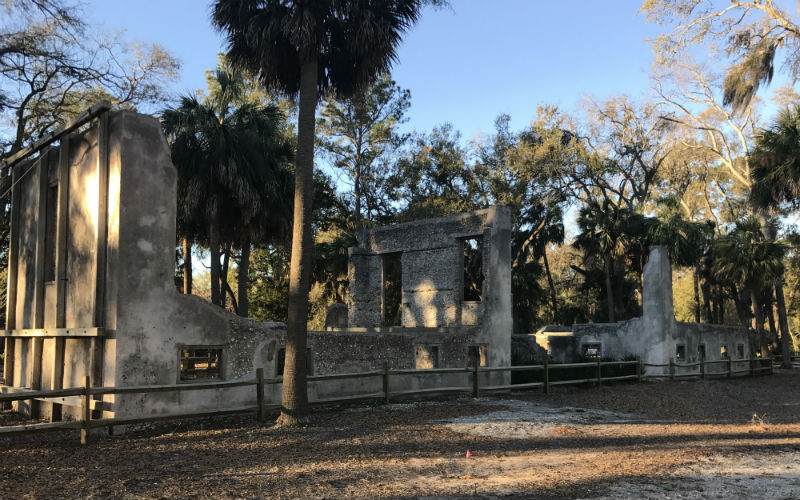
Longtime reader Barry Wingard of Florence sent along this photo of some South Carolina ruins. What and where is this? Send your best guess – plus your name and hometown – to feedback@statehousereport.com. In the subject line, write: “Mystery Photo guess.”
Last week’s mystery
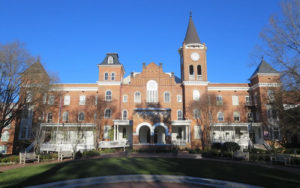 Last week’s Mystery Photo was Wilson Hall at Converse College in Spartanburg. (See SC Encyclopedia below for more on the college).
Last week’s Mystery Photo was Wilson Hall at Converse College in Spartanburg. (See SC Encyclopedia below for more on the college).
Congratulations to these devoted readers who correctly identified the photo: Dale Rhodes of Richmond, Va.; George Graf of Palmyra, Va.; Tom Elmore of Columbia;
Graf sent along this interesting information: “According to collegedata.com, Converse, founded in 1889, is a private, liberal arts college for women. Its 70-acre campus is located in downtown Spartanburg, near the Blue Ridge Mountains. Entrance is moderately difficult (60% get accepted).
Ethnicity of Students from U.S.
- 0% American Indian/Alaskan Native; Native Hawaiian/ Pacific Islander
- 0.6% Asian
- 8.4% Black/African-American
- 4.5% Hispanic/Latino
- 4.4% Multi-race (not Hispanic/Latino)
- 68.8% White
- 13.4% Unknown
International students: 1.6%
- Send us a mystery: If you have a photo that you believe will stump readers, send it along (but make sure to tell us what it is because it may stump us too!) Send to: feedback@statehousereport.com and mark it as a photo submission. Thanks.
HISTORY: Converse College
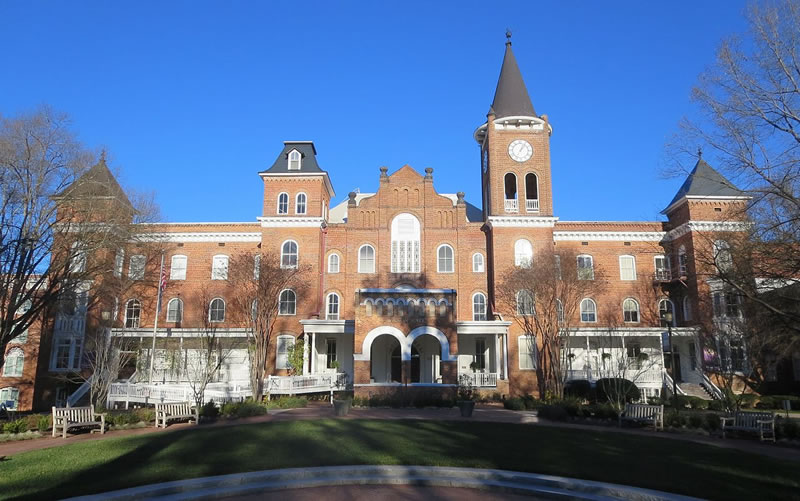
S.C. Encyclopedia | Converse College was founded in 1889 by a group of Spartanburg leaders to provide for the education of young middle-class women. The institution was named to honor its founder Dexter Edgar Converse, a local textile-mill owner and one of the town’s most respected men. Converse later wrote, “It is my conviction that the well-being of any country depends much upon the culture of her women, and I have done what I could to found a college that would provide for women thorough and liberal education, so that for them the highest motives may become clear purposes and fixed habits of life.”
The founders purchased the site of the defunct St. John’s College on Main Street in Spartanburg and secured funds for erecting the first building. They appointed Benjamin Franklin Wilson, pastor of the First Presbyterian Church, the first president of the college (1890–1902). The college opened its doors in the fall of 1890, enrolling 117 students. Unlike many southern women’s colleges, Converse offered students a course of study roughly equivalent to that offered by male colleges. Until 1898 the college also included a preparatory department.
During the tenure of its second president, Robert Paine Pell (1902–1932), Converse College expanded its physical plant, endowment, and enrollment and increased its academic standards. The college established a School of Music in 1910. Two year later Converse was accepted into the Association of Colleges and Preparatory Schools of the Southern States. Converse’s highly respected conservatory-style musical education drew students from all over the United States. The faculty and students of the music school, as well as local alumnae, spearheaded the development of the South Atlantic States Music Festival, an annual event that brought musicians with national and international stature to perform in Spartanburg.
The middle of the century brought challenges. Like most southern colleges, Converse struggled with declining enrollment and financial difficulties during the Great Depression, but enrollment began to grow again by the 1935–1936 academic year. With the entrance of the United States into World War II, the college opened its doors to educational programs for soldiers stationed at nearby Camp Croft and to Wofford College juniors and seniors after their classroom buildings became army training facilities.
The late twentieth century brought more changes. The administration focused on building a high-quality faculty, hiring more faculty with Ph.D.s. The college added a Master of Arts in Teaching program in 1962, the first of several coeducational graduate programs Converse would add in the coming years. In 1968 the college admitted its first African American student, and in the ensuing decades its student body grew in ethnic and economic diversity. Converse II, a bachelor’s degree program specially tailored for adult women over twenty-five, was established in 1983.
In 2000 the college was listed among the top fifteen regional colleges and universities in the Southeast by U.S. News and World Report. Under the leadership of its eighth president, Nancy Oliver Gray, Converse pursued a $75 million capital campaign and an expansion of its physical plant.
Converse has educated thousands of South Carolina and southeastern women who became leaders in their communities, their professions, and the arts. Among the college’s most famous alumnae are the novelist Julia Mood Peterkin (A.B., 1897; A.M., 1898); the composer Lily Strickland (1901–1904; honorary D.M., 1924); the novelist Elizabeth Boatwright Coker (A.B., 1929); and the historian Carol Bleser (A.B., 1960).
— Excerpted from an entry by Melissa Walker. To read more about this or 2,000 other entries about South Carolina, check out The South Carolina Encyclopedia, published in 2006 by USC Press. (Information used by permission.)















 We Can Do Better, South Carolina!
We Can Do Better, South Carolina!